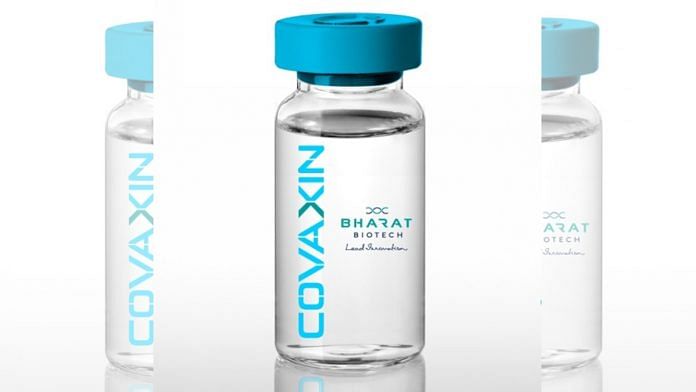New Delhi: India’s first indigenous Covid-19 vaccine candidate Covaxin produced a robust immune response in monkeys, revealed a study published by Indian Council of Medical Research (ICMR) and Hyderabad-based biotechnology company Bharat Biotech.
Covaxin is being developed by Bharat Biotech in collaboration with researchers from the ICMR’s National Institute of Virology, which is based in Pune.
The study, which is yet to be peer-reviewed, was published Friday and shared the results from the animal trials of the vaccine candidate. It claimed that the two-dose vaccine was able to effectively prevent the virus from replicating in the nasal cavity, throat and lung tissues of monkeys.
“To summarise, the vaccine candidate was found to generate robust immune responses. Thus, preventing infection and disease in the primates upon high amounts of exposure to live SARS-CoV-2 virus,” noted Bharat Biotech, in a statement.
Also read: Oxford and Covaxin to Sputnik V — the many Covid vaccines in trial & how they’re faring
Study and development of Covaxin
The two-dose vaccination regimen of Covaxin was administered in 20 rhesus macaques, a primate species commonly found in India.
The macaques were divided into four groups of five monkeys each. One group was administered with a placebo, while the other three groups were immunised with three different vaccine candidates — all developed by Bharat Biotech — at 0 and 14 days.
The three different vaccine candidates have the same basic formula, but have different adjuvants or doses. Adjuvants are substances that improve the immune response generated by a vaccine.
All the macaques were exposed to the SARS-CoV-2 virus, 14 days after the second dose.
The team found that the formation of SAR-CoV-2 specific antibodies began three weeks after the vaccination and continued to increase till day 35.
The study also provides details about how the vaccine was developed.
Vero CCL-81 cells — a line of cells grown from the kidney of a normal adult African green monkey — were initially grown in a medium containing 5-10 per cent newborn calf serum.
These cells were exposed to the SARS-CoV-2 virus in bioreactors under controlled conditions, which were harvested after about 36 hours and then inactivated.
Using this inactivated virus, three vaccine formulations were prepared. The first one is called BBV152A, which includes three microgram (µg) of the inactivated virus, alum (an adjuvant) and imidazoquinoline, another adjuvant that helps the body better recognise RNA from viruses.
The second formulation BBV152B contains 6 µg of the inactivated virus as well as alum and imidazoquinoline. The third formulation BBV152C also had 6µg of inactivated virus, and alum, but no imidazoquinoline.
BBV152A generated the highest antibody response, the researchers said in the study.
Also read: How the world can fight back the fear of a coronavirus vaccine
Covaxin is an inactivated virus
The human trials of Covaxin have already started in India after the Central Drugs Standard Control Organisation (CDSCO), the country’s apex drug quality regulator, granted Bharat Biotech permission to initiate Phase 1 and Phase 2 human clinical trials on 29 June.
Covaxin vaccine falls under the category of inactivated vaccines. In such vaccines, the pathogen is ‘deactivated’ so that it can no longer cause infection. However, parts of the virus can still be identified by the body’s immune system, which triggers an immune reaction.
Hepatitis A, influenza, and polio vaccines used in India are some examples of inactivated vaccines.
These are different from live attenuated vaccines, which carry a live but extremely weakened pathogen that cannot cause the disease, such as the measles vaccine or the Bacillus Calmette–Guérin (BCG) vaccine that is used primarily against tuberculosis.
While live vaccines are powerful, they are also risky for people with an impaired immune system.
Inactivated vaccines are not as powerful as live ones and typically require booster shots. However, the inactive pathogen cannot replicate in the vaccinated person, making it safer for people with an impaired immune system response.
Also read: Vaccine hesitancy growing in parts of world as people doubt effectiveness, Lancet study says







How about humans? Let ICMR not meddle in clinical trial by calling shots much before the analysis of data. In a hurry, a good product may give false negative, if trial done in a hurry?